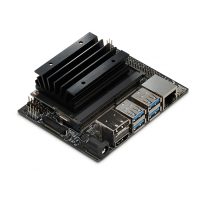Platform Adaptation and Bring-Up
Jetson Nano Platform Adaptation and Bring-Up Guide DA_09361-002 | 20
Name of the output cable connected on boot, expressed as an index into extcon-
gpio,out-cable-names. The first element is index 0, and so on. If not specified,
the system assumes that no cable is to be connected. This property is valid if no
GPIOs are provided for cable states.
• wakeup-source
A Boolean; true if the device can wake up the system.
For the detailed information about extcon, refer to the documentation at:
kernel/kernel-4.9/Documentation/devicetree/bindings/extcon/extcon-gpio-
states.txt
• Create an extcon device node and property list based on the device tree structure
described above and the table of GPIO states and cable states in Table 3. This
example shows a node definition which assumes GPIO_PCC4 is the VBUS_DTECT
pin and GPIO_PZ1 is the ID pin.
vbus_id_extcon: usb_otg {
compatible = "extcon-gpio-states";
extcon-gpio,name = "VBUS_ID";
extcon-gpio,wait-for-gpio-scan = <0>;
extcon-gpio,cable-states = <0x3 0x0
0x0 0x2
0x1 0x2
0x2 0x1>;
gpios = <&gpio TEGRA_GPIO(CC, 4) 0
&gpio TEGRA_GPIO(Z, 1) 0>;
extcon-gpio,out-cable-names =
<EXTCON_USB EXTCON_USB_HOST EXTCON_NONE>;
#extcon-cells = <1>;
};
The USB 2.0 Micro B connector, J28, has the connector’s ID pin floating and the
VBUS_DETECT pin of the connector wired out to GPIO00, which corresponds to
GPIO_PCC4. Hence J28 can only function in the device role.

